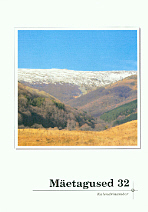Mis on rituaalne aasta? Küsimus ja vastused
The question of the ritual year and the answers to it
Author(s): Emily LyleSubject(s): Customs / Folklore
Published by: Eesti Kirjandusmuuseum
Keywords: isomorphism; life cycle; lunar cycle; nychthemeron; ritual year; summer half; winter half
Summary/Abstract: The author asks the question concerning the nature and identity of the ritual year. Other supplementary questions that can be asked are whether it is actually possible to locate an underlying coherence at all and, if so, what historical and geographical contexts would embrace it most fully. The author also inquires why there is no recognised current theory about the ritual year. In her approach she emphasises analogical thinking and takes the human life cycle as a key to the understanding of the patterning of the year. In the analysis, four levels are considered: whole eras or time itself at the large scale and with seconds or less at the small scale are dealt with, and the basic series of analogies has the human life cycle as the largest in scale and works down through the year and the month to the 24-hour day as the smallest. Thus, a reference set is established in which two tasks have to be considered: the first is to become familiar with the patterning of examples of the overall cyclical sequence, and the second is to categorise the divisions the cycle. The author has developed Tolstoy’s observation concerning “the isomorphism of the periods after midnight in the diurnal circle and after Christmas in the year circle” and also the idea that Dumézil’s triad of functions of physical force, prosperity and the sacred relates more fundamentally to the life stages of young men, mature men and old men than to the social groups he mentions of warriors, cultivators and priests.
Journal: Mäetagused. Hüperajakiri
- Issue Year: 2006
- Issue No: 32
- Page Range: 7-16
- Page Count: 10
- Language: Estonian

